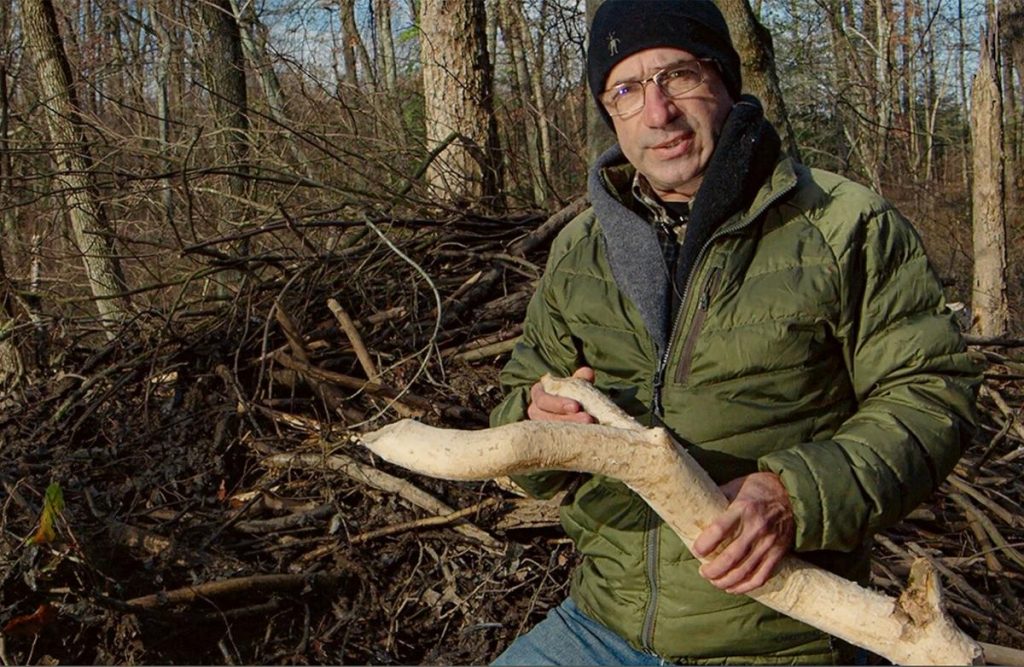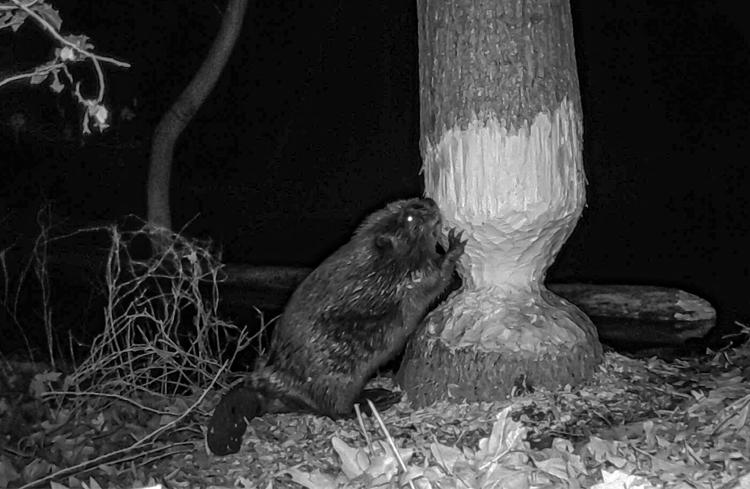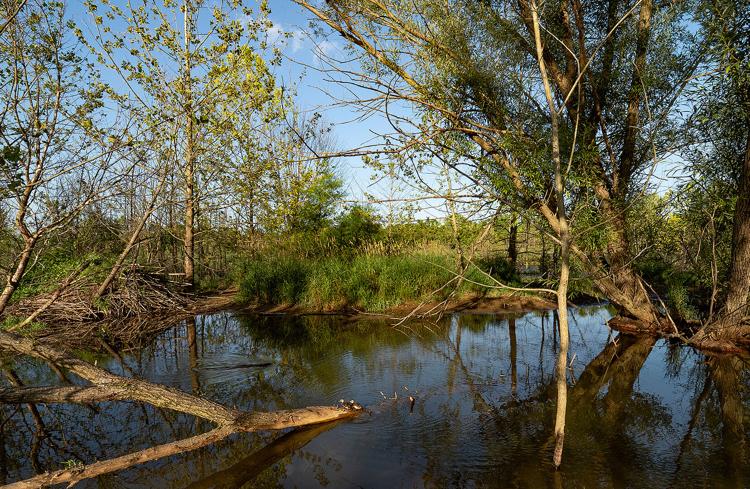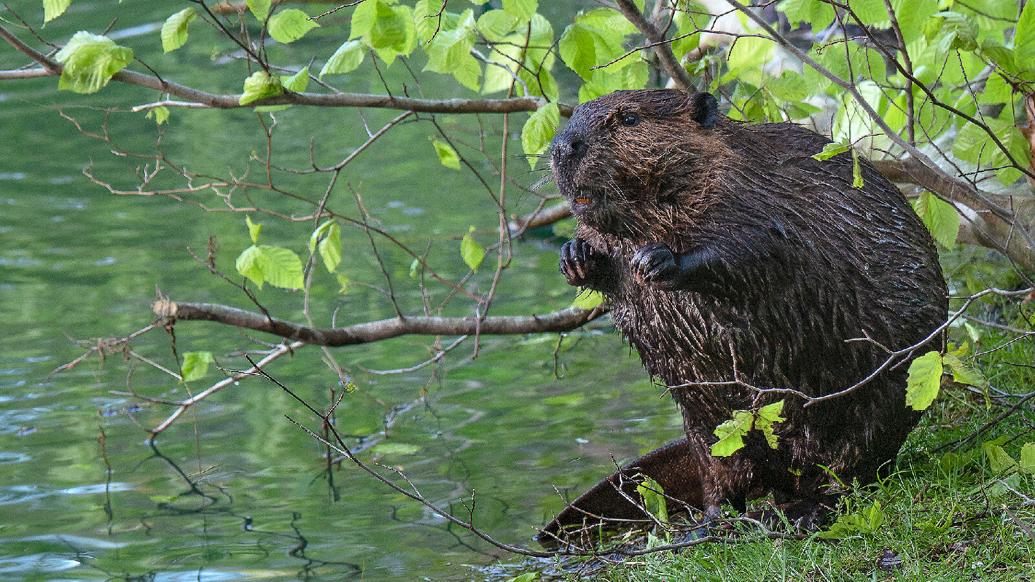By Karl Blankenship
Bay Journal
Scott McGill was standing beside a stream that, to many people, wouldn’t look like a stream at all. But if an explorer had been plopped down here four centuries ago, in what is now Baltimore County, this is the way a stream might have looked, he said.
This section of Long Green Creek is a sprawling ponded area of 7 or 8 acres, surrounded by shrubs and trees and flanked by marshy soil that sank with each step. Muddy, vegetated mounds occasionally pierced the surface.
Wildlife, especially waterfowl, like it that way. “We have flocks of black ducks and woodies,” said McGill, who heads Ecotone, an ecological restoration company that has been working on this stretch of stream for years. “We’ve even had pintails, which typically aren’t common around here.”
Yet he wasn’t taking credit for the results. If he had done the work, McGill said, “it would have cost millions, and it wouldn’t have been as good.”
His contribution was modest, having planted the streambank with trees that turned out to be beaver food. It was the beavers who transformed the stream.
Now, McGill and a small group of “beaver believers” are hoping to transform the way the Chesapeake Bay region thinks about its waterways — and the role that North America’s largest rodent should play in restoring their health.
Allowing those furry engineers to replumb the stream systems, they contend, can sharply reduce Bay pollution at a fraction of anticipated costs. The revitalized streams would also increase the diversity and productivity of streams for frogs, birds and fish, including some rare species.
Stream systems that include beaver-engineered ponds, they say, will also buffer the impacts of climate change by reducing downstream flooding, mitigating drought and recharging groundwater.

Scott McGill of Ecotone visits a beaver lodge on Windlass Run in Baltimore County, MD. He says beavers have been a cost-effective part of Ecotone’s stream restoration projects. Bay Journal photo by Dave Harp
The idea isn’t far-fetched: Beaver-based restoration is embraced in the Pacific Northwest, where conservation groups and federal agencies are enlisting the rodents in low-cost, low-tech efforts to restore stream systems that are vital for salmon.
The Bay region lags in such beaver buy-in, although McGill helped to arrange a three-day conference near Baltimore in early 2020. Dubbed “BeaverCon,” it brought people from across the continent and Europe to jump-start that discussion. Now, he and like-minded beaver advocates are putting together a proposal in which landowners might get credit for reducing water pollution by maintaining beaver dams on their properties.
The biggest impediment? People mainly view beavers as a nuisance.
Touring the beaver pond at Long Green Creek with McGill, Bay Journal columnist and Salisbury University environmental studies professor Tom Horton recalled his standoff with beavers 15 years ago, at his home along Maryland’s Nanticoke River. When a pair began chewing his native vegetation, he wanted them gone. “A guy at the Department of Natural Resources said, ‘You ought to let them dam it.’ I said, ‘they’re eating my damn trees.’?”
He called a trapper. Today, Horton says that was a mistake, having written and narrated a Bay Journal film, Waters Way, which touts the stream revitalization potential of beavers.
Changing public perception, though, will be a challenge. “If I mention beavers to any group — my students or faculty — the first two reactions are they cause flooding and they chew down trees,” Horton said. “That is where you are starting at.”
Ecosystem amnesia
Not far from the beaver pond, McGill stood on a dry bank above a narrow water channel running through a 2-foot-deep ditch. This is pretty much what people in the mid-Atlantic have come to think of as a “natural” waterway, McGill said, “[but] you should not be able to walk here in sneakers without getting your feet wet.”
That people see such degraded streams as natural while considering beaver ponds out-of-place nuisances is a symptom of what some call “ecological amnesia.”
“Most of our understanding of this continent came after beavers were already removed from the landscape,” said Frances Backhouse, author of a recent book on beavers, Once They Were Hats, at BeaverCon. “And that really skewed our perception of what natural ecosystems look like and how they function. It also delayed our scientific study of this animal because they simply weren’t there to study.”
In 1607, when Europeans established Fort James in the colony of Virginia, North America had between 60 million and 400 million beavers — somewhere between 10 and 75 per square mile.
Beavers were quickly recognized as a valuable commodity for meat and the oils they secreted, but especially for their fur, which was turned into hats. The pursuit of beavers was so intense that Virginians and Marylanders engaged in a sporadic shooting war in the mid-1600s for control of the Chesapeake beaver trade.
Beavers were quickly trapped from the region’s landscape, foreshadowing what would happen across the continent. By the mid-1800s, they were gone from Pennsylvania and probably the rest of the Bay watershed. Continentwide, their population was reduced to around 100,000.
A landscape transformed
Lost with the beavers was the critical role they played in making streams an incredibly inefficient way to move water.
Four hundred years ago, the Bay watershed was largely forested, dominated by old-growth trees and soft, sponge-like forest floors that absorbed most of the rain before it had a chance to reach a stream. Most water flowed to streams through groundwater, not runoff.
Streams often were not the single-channel waterways people envision today. Instead, they consisted of multiple, braided rivulets. When it rained, water from those rivulets quickly spread across the floodplain, where wetland plants slowed the flow, allowing much of the water to soak into the ground.

A beaver colony has taken over Bear Cabin Creek, just below this housing development in Baltimore County. Bay Journal photo by Dave Harp
The downstream flow was further hindered by the huge beaver population. Using twigs, sticks, small trees, mud and stones, their sturdy dams often stood several feet high and could hold back acres of water. The resulting ponds raised water levels enough for the beavers to build underwater entrances to lodges that offered protection from predators.
As water levels rose, beavers made their dams higher and wider, trapping even more water. They eventually abandoned sites when nearby building supplies and food (small trees and shrubs) were used up. The vacated dams broke down, and a succession of wetland plants moved back into the nutrient-rich soils left behind, until the next wave of beavers arrived.
As a result, stream valleys were a mosaic of ponds interspersed with wet meadows through which stream threads would flow. Because these systems trapped so much freshwater, the Bay was saltier. Oysters thrived in Baltimore Harbor, which is far too fresh for them today.
As beavers were trapped out and settlers moved in, forests were cut and streamside land was drained for farming. Streams were transformed into systems designed to drain land efficiently and flush both water and pollutants downstream.
Sediment, which once largely settled onto floodplains or behind beaver dams, moved downstream with ease. The port of Baltimore, established on the Patapsco River in 1706, was relocated twice in the century that followed, as channels filled and became inhospitable to ships.
Grace Brush, of Johns Hopkins University, has reconstructed the watershed transformation story by studying sediment cores drawn from the Bay bottom. Pollen in those cores show that plant communities changed from wet-meadow species before colonization to plants that prefer dry conditions, such as ragweed.
The lost floodplains served another important function. Allowing those areas to be covered with a thin film of water created pockets of oxygen-starved soils. That promoted bacterial communities that removed nitrogen from the water, even as increasing amounts of the nutrient were poured onto the landscape.
Unlike the beaver pond, the channelized stream McGill stood beside had lost its connection with the floodplain — and therefore much of its ability to reduce nitrogen. As streams across the watershed were similarly transformed, more nutrients entered the Bay, where they now cause oxygen-starved “dead zones.”
“In order to restore the Bay’s productivity, we must increase the wetness of the land and restore its capacity to denitrify,” Brush said at BeaverCon. “And beavers could play a large role in this process.”
Nature’s pollution control
In the 1970s, the Smithsonian Environmental Research Center established several long-term monitoring sites to understand how land use was affecting streams. They got a surprise in 1990, when beavers built a dam just a few yards upstream of one of the sites on SERC’s property near Annapolis.
“When we saw the beaver dam, I had two reactions,” recalled Tom Jordan, a senior scientist at the research center. “One, this is a perfect experiment. Thank you, beavers. And the other was, this is really going to be great for ice skating.”
Monitoring of the site, and a nearby undammed stream, showed that the beaver structure improved water quality. It reduced nitrogen by 18%, phosphorus by 21% and sediment by 27%.
The notion that beavers were doing things people wanted — for free — was not lost on those working on streams in surrounding Anne Arundel County.
Two decades ago, the county was working to preserve wetlands with rare plants that required groundwater seepage to survive. They designed projects to hold back water and divert it into the soil.
“At some point, it clicked that, ‘Hey, this is very similar to what beavers do,’” said Erik Michelsen, deputy director of the county’s bureau of watershed protection and restoration.
Today, Michelsen said, the county increasingly designs projects with the intent that beavers will move in and take over.
As beavers occupy new areas, their impact is magnified — at no cost, and without having to go through a sometimes onerous, permitting process. Further, Michelsen said, “they’re a maintenance crew that is on-site constantly.”
Worth a dam — or more?
Keeping water on the landscape requires more space than a single stream channel, though Michelsen and McGill said that even on densely developed land a series of beaver dams can still hold back large amounts of water.
But the notion that water should be kept on the landscape is often at odds with both human perceptions of how streams should function and with traditional approaches to restoring waterways. Essentially, stream restoration efforts often seek to establish stable channels that efficiently move water downstream to prevent flooding, while adding in pools and riffles to improve habitat.
“Usually, we’re kind of gun-shy about having water stick around too long on the landscape,” Michelsen said.
But those engineered streams are costly. They typically require driving bulldozers into waterways to gouge away centuries of accumulated sediment and reconfigure channels, but they produce the predictable results humans often prefer.
Backers of beaver-based restoration, which started in Western states to improve habitat for salmon, advocate for a “process-based” approach in which conditions are established for beavers to recolonize an area and transform a more natural stream valley over time.
Instead of digging away several feet of accumulated sediment along a deeply incised stream at huge expense, they allow beavers to build a cascading series of dams that raises the stream level, allowing it to spread over a new floodplain.
Getting beavers on the job can be tough, as rapidly flowing water in many of today’s degraded streams can blow out any beaver dam. The use of wooden “beaver dam analogs,” which mimic beaver dams, can reduce the flow until beavers take over.
“In a lot of our work, we’ve tried to simplify our restoration approaches,” Michelsen said. “If the endgame is to have that whole system submerged by beavers moving into the system, why spend hundreds of thousands of dollars designing fine channels and all these other kinds of features?”
McGill said that a traditional stream restoration project costs, on average, about $500 a foot. But simple techniques using beaver dam analogs are a fraction of that cost. There are trade-offs. Beaver engineers are less predictable than their human counterparts, and their timetable is often longer: A stream transformation may take years.
But, McGill points out, the Bay watershed is drained by more than 100,000 miles of streams and many, if not most, are degraded. Beavers are the only available work crew that can take on the job, do the ongoing maintenance and produce a supply of new dam builders to expand the scope of their work.
“We’re not going to be able to fix all these streams with rocks and logs and bulldozers,” McGill said. “How are we going to scale up restoration to make a difference? The only way is using nature to restore nature.”
Not a panacea
Not everyone appreciates the beavers’ hard work. Beavers and humans are the two species that most directly impact streams and floodplains, so conflicts are no surprise. Not only did humans drain floodplains, but those relatively level areas often became prime locations for infrastructure — canals, railroads, roads, even sewer lines — all of which can be disrupted by beaver ponds.
Road crews nationwide are estimated to spend more than $100 million a year dealing with beaver problems.
Road culverts are a particular problem because the sound of water rushing through the narrow openings attracts beavers who treat it as a leaking dam and seek to “patch” it.
“It’s almost like a beaver magnet,” said Deborah Landau, a conservation ecologist with The Nature Conservancy who has helped address beaver problems near conservancy properties in Maryland. “All of these things together are why beaver-human interactions tend to be negative interactions.”
Flooding can often be managed by installing beaver-tricking devices. Typically, they include pipes that drain water from the top of a beaver pond — limiting the height of the water — and send it downstream, usually underwater so as not to alert the beavers.
One study in Virginia found that every $1 spent on flow control devices at culverts saved more than $8 in beaver-related maintenance expenses.

Captured by an infra-red camera, a beaver chews on an ash tree at Cottingham Farms in Easton, MD. Beavers do most of their work at night. Bay Journal photo by Dave Harp
Still, beaver boosters acknowledge that there are places where the rodents will never fit in. The Beaver Institute, a nonprofit that seeks to build awareness of the beavers’ ecosystem benefits, estimates that trapping remains the most viable option for about 25% of conflicts. Removing beavers is ongoing job, though, because they continue to move in.
Another concern is the impact beaver dams could have on fish movement. Beaver advocates don’t believe that’s a problem, noting that peak beaver populations coincided with peak populations of migratory fish that once packed the region’s rivers.
Evidence from Western states also suggests beaver improvements to stream health outweigh other impacts. Some fisheries scientists caution that may not be true for wetter Eastern aquatic environments, though. With the poor condition of some species, including river herring, shad and brook trout, they worry that even slight impacts could have ramifications.
Several years ago, Greg Garman, director of Virginia Commonwealth University’s Rice Rivers Center, participated in a small project in the Rappahannock where river herring were trying to migrate past beaver dams. “On several occasions, I was able to watch blueback herring wiggle their way through a beaver dam. I probably wouldn’t have believed it unless I saw it myself.”
But, he said, while it was “technically possible” to get past, it also didn’t appear that many were doing so. Still, he said, the issue warrants more study.
Incentivizing beaver recovery
The demise of beavers more than a century ago gradually gave way to efforts to return them to once-lost habitats.
Pennsylvania began reintroductions in 1901, and Virginia began a few decades later. The most innovative restoration was by Idaho, which in the 1940s returned beavers to remote habitats through parachute drops.
Though far below historic levels, populations have rebounded. But their restoration potential remains huge, if people can learn to live with them. To incentivize that, McGill and others are working on a proposal that would give local governments and landowners nutrient reduction credits toward Bay cleanup goals for having beaver dams on their property.

A beaver swims by two wood duck chicks perched on a log in a wetland formed by a beaver dam on Long Green Creek in Baltimore County, Bay Journal photo by Dave Harp
Their idea is simple and far from novel: Such credits are given for land planted in trees, turned into stormwater detention ponds, or transformed by stream restoration projects. Why shouldn’t land covered by a beaver pond, especially if it is part of a restoration project, be treated differently?
Michelsen said that nutrient reduction credits would help local governments and others to put a price on beaver benefits.
That could lead local governments to make land use decisions with beavers in mind. They might, for instance, provide additional protection for low-lying areas already susceptible to flooding in anticipation that beavers will eventually arrive and spur an effective floodplain. Land conservation programs might target those areas as well.
“So much of what we do, whether in business or in government is really trying to do a cost-benefit analysis,” Michelsen said. “We know pretty well what the costs are, whether it be having to trap beavers out or to take steps to adaptively manage them or replace infrastructure that might be at risk. But we don’t have a sense of the quantifiable benefits. So, it’s really an attempt to sort of even that scale.”
But figuring out how much nutrient reduction credit to give beaver ponds will be a challenge — especially because their size and location can change each year.
David Wood of the nonprofit Stormwater Network coordinates the state-federal Bay Program’s stormwater workgroup. He said crediting beaver ponds was an “interesting concept,” especially as evidence of ecosystem benefits accumulates, but that, “as with anything, I think the devil is in the details when it comes to crediting potential.”
Nonetheless, with the region far off track toward meeting its 2025 Bay cleanup goals, people are seeking new ways to get the job done — and it’s not the first time the idea of enlisting beavers has surfaced. In the early 2000s, Rebecca Hanmer, then director of the U.S. Environmental Protection Agency’s Chesapeake Bay Program office, was visited by a scientist from who talked about beavers benefits.
As she listened, she began to understand how beaver dams remove nitrogen from stream systems similar to the technologies used at wastewater plants. “The epiphany was the similarity between how he was describing the matrix of a twig-created beaver dam and what the engineers were designing to sell for big bucks as biological nitrogen removal,” she said.
Hanmer arranged for the scientist to speak at a Bay Program staff meeting. “That day, people just looked at me and him like we were crazy,” she said. “That was a long time ago. Things change. Maybe some things at least can change for the better.”
Karl Blankenship is the founding editor of the Bay Journal. [email protected]




Try Above
visit